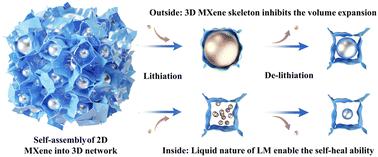当前位置:
X-MOL 学术
›
Energy Environ. Sci.
›
论文详情
Our official English website, www.x-mol.net, welcomes your
feedback! (Note: you will need to create a separate account there.)
An integrated self-healing anode assembled via dynamic encapsulation of liquid metal with a 3D Ti3C2Tx network for enhanced lithium storage
Energy & Environmental Science ( IF 32.4 ) Pub Date : 2022-10-20 , DOI: 10.1039/d2ee02147a Hanning Zhang 1 , Pengyu Chen 1 , Huan Xia 1 , Gang Xu 1 , Yaping Wang 1 , Tengfei Zhang 2 , Wenwen Sun 1 , Muhammadali Turgunov 3 , Wei Zhang 1 , ZhengMing Sun 1
Energy & Environmental Science ( IF 32.4 ) Pub Date : 2022-10-20 , DOI: 10.1039/d2ee02147a Hanning Zhang 1 , Pengyu Chen 1 , Huan Xia 1 , Gang Xu 1 , Yaping Wang 1 , Tengfei Zhang 2 , Wenwen Sun 1 , Muhammadali Turgunov 3 , Wei Zhang 1 , ZhengMing Sun 1
Affiliation

|
Given their high theoretical capacity, alloy-based anodes are promising candidates for lithium-ion batteries (LIBs) to meet the stringent demand of today's portable electronic devices and electric vehicles. However, the intrinsic limitations of volume expansion and irreversible pulverization lead to the sharp capacity decay and short cyclic life of the LIBs. Liquid metal (LM), possessing an inborn large capacity and inheriting deformability as liquids, can fundamentally avoid a large volume change during the electrochemical reactions. Herein, we report a facile strategy to self-assemble 2D Ti3C2Tx MXene into a 3D architecture, and simultaneously in situ encapsulate eutectic gallium indium (EGaIn) within the individual “MXene cell”. Inside the cell, the extraction of lithium ions from the ternary solid alloy brings LM back to the binary liquid state, enabling a self-healing process of the cracked or pulverized structure; outside the cell, the elastic network of the Ti3C2Tx skeleton buffers the volume expansion of the lithiated EGaIn. The as-prepared LM-Ti3C2Tx anode exhibited a superior rate capability (489 mA h g−1 at 5 A g−1) and excellent cycling stability (409.8 mA h g−1 after 4500 cycles at 5 A g−1, 90.8% capacity retention). Furthermore, we demonstrated that the reversible liquid–solid phase transformation and the formation of a distinct indium core/gallium shell structure is responsible for its self-healing properties. This work shows great potential for solving the inherent volume expansion problems of alloy-based anode materials.
中文翻译:

通过液态金属的动态封装与 3D Ti3C2Tx 网络组装的集成自愈阳极,用于增强锂存储
鉴于其高理论容量,合金基负极有望成为锂离子电池 (LIB) 的候选材料,以满足当今便携式电子设备和电动汽车的严格需求。然而,体积膨胀和不可逆粉碎的内在局限性导致锂离子电池的容量急剧衰减和循环寿命短。液态金属(LM)具有先天的大容量并继承了液体的可变形性,可以从根本上避免电化学反应过程中的大体积变化。在此,我们报告了一种简便的策略,将 2D Ti 3 C 2 T x MXene 自组装成 3D 架构,同时原位将共晶镓铟 (EGaIn) 封装在单个“MXene 电池”内。在电池内部,从三元固体合金中提取锂离子使 LM 恢复二元液态,从而实现破裂或粉碎结构的自我修复过程;在电池外,Ti 3 C 2 T x骨架的弹性网络缓冲了锂化 EGaIn 的体积膨胀。所制备的LM-Ti 3 C 2 T x阳极表现出优异的倍率性能(489 mA hg -1在5 A g -1)和优异的循环稳定性(在5 A g -1 4500次循环后409.8 mA hg -1, 90.8% 的容量保持率)。此外,我们证明了可逆的液固相变和独特的铟核/镓壳结构的形成是其自愈特性的原因。这项工作显示出解决合金基负极材料固有的体积膨胀问题的巨大潜力。
更新日期:2022-10-20
中文翻译:

通过液态金属的动态封装与 3D Ti3C2Tx 网络组装的集成自愈阳极,用于增强锂存储
鉴于其高理论容量,合金基负极有望成为锂离子电池 (LIB) 的候选材料,以满足当今便携式电子设备和电动汽车的严格需求。然而,体积膨胀和不可逆粉碎的内在局限性导致锂离子电池的容量急剧衰减和循环寿命短。液态金属(LM)具有先天的大容量并继承了液体的可变形性,可以从根本上避免电化学反应过程中的大体积变化。在此,我们报告了一种简便的策略,将 2D Ti 3 C 2 T x MXene 自组装成 3D 架构,同时原位将共晶镓铟 (EGaIn) 封装在单个“MXene 电池”内。在电池内部,从三元固体合金中提取锂离子使 LM 恢复二元液态,从而实现破裂或粉碎结构的自我修复过程;在电池外,Ti 3 C 2 T x骨架的弹性网络缓冲了锂化 EGaIn 的体积膨胀。所制备的LM-Ti 3 C 2 T x阳极表现出优异的倍率性能(489 mA hg -1在5 A g -1)和优异的循环稳定性(在5 A g -1 4500次循环后409.8 mA hg -1, 90.8% 的容量保持率)。此外,我们证明了可逆的液固相变和独特的铟核/镓壳结构的形成是其自愈特性的原因。这项工作显示出解决合金基负极材料固有的体积膨胀问题的巨大潜力。











































 京公网安备 11010802027423号
京公网安备 11010802027423号